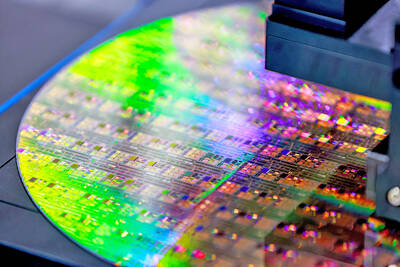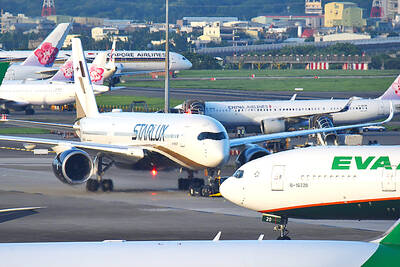Taiwan Semiconductor Manufacturing Co (TSMC, 台積電), the world’s largest contract chipmaker, yesterday said the Internet of Things (IoT) would be the industry’s major growth driver in the next three to five years.
The uptake of the IoT, including wearable devices, would spur demand for key components such as microcontrollers, image sensors and Wi-Fi and Bluetooth sensors, said John Wei (尉濟時), a senior director of TSMC’s mobile and computing business division.
“Those components will not entirely be made at 8-inch factories. Many of them, such as Wi-Fi and Bluetooth [sensors], are produced at 12-inch factories… The demand will be diverse from low-end [chips] to high-end [chips],” Wei told reporters on the sidelines of a press conference for the annual SEMICON exhibition in Taipei.
Wei said the IoT would not represent significant shipments in the near term, but it would be a big growth engine for the semiconductor industry in next three to five years, when the whole ecosystem and business model matured.
TSMC would be ready with the technologies needed, from power management ICs to application processors, he said.
Wei’s comments echoed TSMC chairman Morris Chang’s (張忠謀) speech on the “Next Big Thing” in March, when he said the IoT would be the industry’s new growth driver, taking over mobile devices such as smartphones and tablets.
SEMI Taiwan president Terry Tsao (曹世綸) yesterday said that the global semiconductor equipment market is expected to expand at a rate of 20.8 percent this year to US$38.4 billion and would grow about 11 percent year-on-year to US$42.6 billion next year, with Taiwan being the top consumer.
Tsao attributed the growth to new investment in IoT technologies.
Separately, equipment maker ASML Holding NV said its customers using advanced extreme ultraviolet (EUV) lithography would mass produce wafers by the end of 2016.
“We have made some progress. And we believe the EUV system will allow our customers to save manufacturing costs effectively,” ASML Taiwan director of technical marketing Peter Cheng (鄭國偉) said on the sidelines of the SEMICON press conference.
“More than one customer have had their EUV lithography machines reach a throughput of 500 wafers per day,” Cheng said.
The daily throughput is expected to increase to 15,000 wafers a day by 2016, based on the company’s roadmap, Cheng said.
Early last month, ASML confirmed that IBM Corp marked an EUV throughput record by producing 637 wafers a day.
EUV is the leading candidate for printing fine patterns for next-generation chips.
TSMC was not certain whether it would start using the EUV system to manufacture chips on 10-nanometer (nm) or 7-nanometer process technologies. TSMC is scheduled to start mass production of 10nm chips in 2017.
SEMI Taiwan said the annual trade show has attracted 650 companies around the world to showcase their latest products at the three-day exhibition, up from last year’s 586 companies.
Shanghai Integrated Circuit Industry Association consultant Xue Zi (薛自) said 13 of its members, including semiconductor equipment supplier North Microelectronics (北方微電子), would attend the show.
The number has doubled from last year, when the association’s members joined the show for the first time, Xue said.

Taiwan’s rapidly aging population is fueling a sharp increase in homes occupied solely by elderly people, a trend that is reshaping the nation’s housing market and social fabric, real-estate brokers said yesterday. About 850,000 residences were occupied by elderly people in the first quarter, including 655,000 that housed only one resident, the Ministry of the Interior said. The figures have nearly doubled from a decade earlier, Great Home Realty Co (大家房屋) said, as people aged 65 and older now make up 20.8 percent of the population. “The so-called silver tsunami represents more than just a demographic shift — it could fundamentally redefine the

Businesses across the global semiconductor supply chain are bracing themselves for disruptions from an escalating trade war, after China imposed curbs on rare earth mineral exports and the US responded with additional tariffs and restrictions on software sales to the Asian nation. China’s restrictions, the most targeted move yet to limit supplies of rare earth materials, represent the first major attempt by Beijing to exercise long-arm jurisdiction over foreign companies to target the semiconductor industry, threatening to stall the chips powering the artificial intelligence (AI) boom. They prompted US President Donald Trump on Friday to announce that he would impose an additional

China Airlines Ltd (CAL, 中華航空) said it expects peak season effects in the fourth quarter to continue to boost demand for passenger flights and cargo services, after reporting its second-highest-ever September sales on Monday. The carrier said it posted NT$15.88 billion (US$517 million) in consolidated sales last month, trailing only September last year’s NT$16.01 billion. Last month, CAL generated NT$8.77 billion from its passenger flights and NT$5.37 billion from cargo services, it said. In the first nine months of this year, the carrier posted NT$154.93 billion in cumulative sales, up 2.62 percent from a year earlier, marking the second-highest level for the January-September

Asian e-commerce giant Shein’s (希音) decision to set up shop in a historic Parisian department store has ruffled feathers in the fashion capital. Anger has been boiling since Shein announced last week that it would open its first permanent physical store next month at BHV Marais, an iconic building that has stood across from Paris City Hall since 1856. The move prompted some French brands to announce they would leave BHV Marais, but the department store had already been losing tenants over late payments. Aime cosmetics line cofounder Mathilde Lacombe, whose brand was among those that decided to leave following